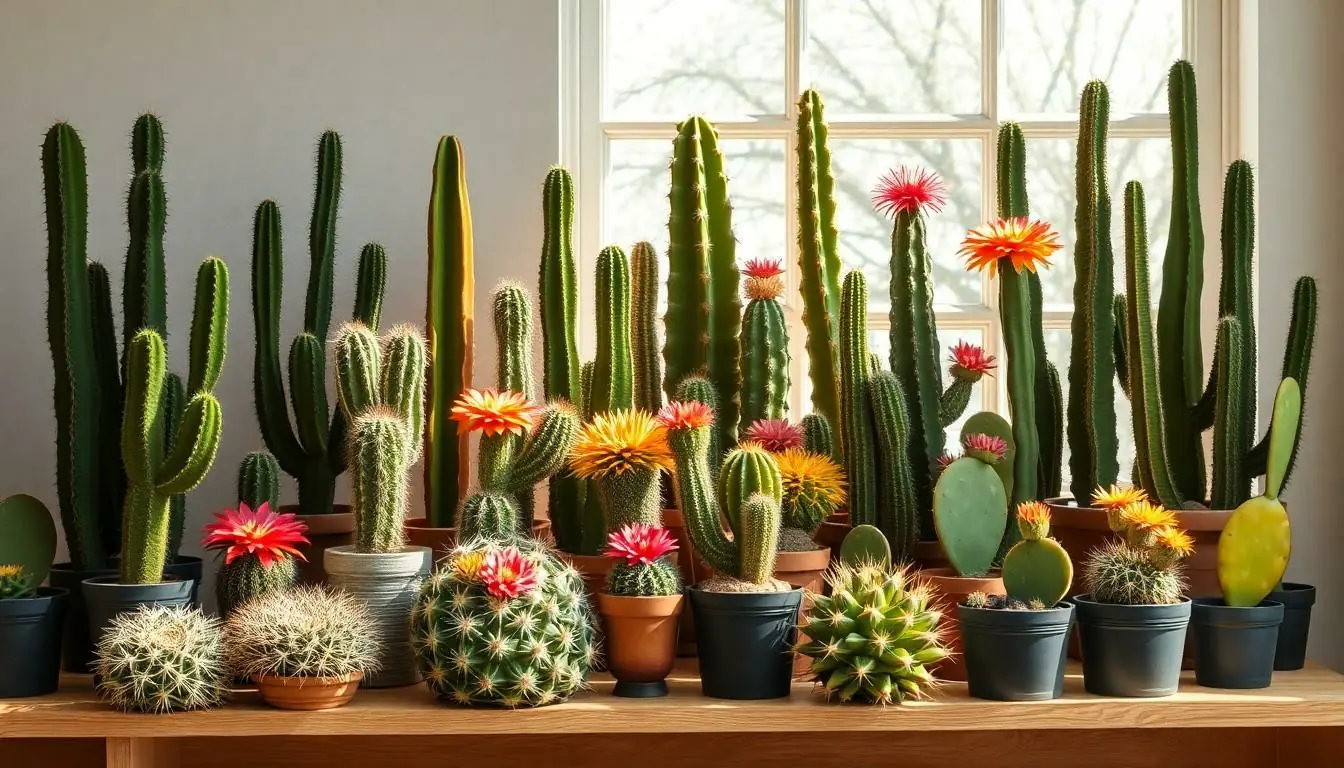Cacti aren’t just for desert landscapes anymore; they’ve made their way into homes as quirky and low-maintenance houseplants. With their unique shapes and vibrant colors, these spiky wonders add a touch of personality to any space. Who wouldn’t want a plant that’s practically begging for neglect?
From the classic barrel cactus to the trendy moon cactus, there’s a type for every personality—whether you’re the nurturing type or more of a “water once a month” kind of plant parent. Plus, they’re the perfect conversation starters. Imagine guests admiring your prickly pals while you casually mention how they thrive on your neglect. Dive into the fascinating world of cactus houseplants and discover which one could be the perfect addition to your indoor jungle.
Table of Contents
ToggleTypes Of Cactus House Plants
Numerous cactus varieties thrive indoors, each offering unique aesthetics and care requirements.
1. Saguaro Cactus
Commonly associated with the American Southwest, the Saguaro can reach impressive heights. Known for its branching arms, this species requires plenty of sunlight.
2. Echinopsis
Echinopsis, also called the globe cactus, features rounded bodies and produces vibrant flowers. These cacti prefer bright light and well-draining soil.
3. Mammillaria
Mammillaria features small, cylindrical shapes covered in spines. This diverse genus includes over 200 species, making them ideal for collectors.
4. Ferocactus
Ferocactus, often known as the barrel cactus, has ribbed bodies and can grow large. These cacti store water efficiently, making them drought-resistant.
5. Opuntia
Opuntia, or prickly pear, is recognizable by its flat pads. Certain species bear edible fruit, while others serve as ornamental plants.
6. Corphophora
Corphophora is a lesser-known variety known for its segmented structure that produces stunning blossoms. These cacti prefer ample light and moderate watering.
7. Rhipsalis
Rhipsalis stands out as a unique cactus due to its trailing, vine-like appearance. Unlike many cacti, it thrives in lower light conditions, making it suitable for dimmer spaces.
8. Astrophytum
Astrophytum is characterized by its star-shaped figure and minimal spines. These cacti are known for their striking appearance and low maintenance needs.
9. Schlumbergera
Schlumbergera, or Christmas cactus, blooms during the holiday season. Its flat, segmented stems flourish in indirect light and prefer humidity.
These types of cactus house plants offer varied options for every plant enthusiast, from novice to seasoned collector.
Popular Cactus Varieties

Cacti come in various types, each with its distinctive characteristics and appeal. Exploring some popular varieties reveals their unique features and care needs.
Saguaro Cactus
Saguaro Cactus, native to the Sonoran Desert, boasts impressive height, reaching up to 40 feet. This iconic cactus has upright, branching arms, giving it a distinctive silhouette. Typically, it can live for over 150 years, making it a long-term investment for any plant lover. Bright white flowers bloom in spring, attracting night pollinators. This cactus thrives in full sun and requires minimal water, especially in winter months. Ensure a well-draining soil mix to prevent root rot. Saguaro cacti serve as striking focal points in home decor.
Echinopsis
Echinopsis, commonly known as globe cactus, offers stunning flowers during spring and summer months. This variety features a round shape and can grow up to 12 inches tall. Colors of its blossoms range from vibrant pinks to rich yellows, enhancing any indoor space. Echinopsis prefers bright light and well-draining soil, thriving under such conditions. Watering should be done infrequently, allowing the soil to dry out between sessions. These cacti are ideal for those who want low-maintenance yet visually appealing plants.
Opuntia
Opuntia, or prickly pear, showcases its flat pads that resemble paddles, making it easily recognizable. Some species produce edible fruit known as “tunas,” offering culinary opportunities. Growing up to 5 feet tall, this cactus adapts well to various environments. Sunlight and minimal water are essential for its health, ensuring vibrant growth. Additionally, Opuntia thrives in well-draining soil to keep roots healthy. With its unique appearance and fruiting ability, this cactus is appealing for collectors and beginners alike.
Care Requirements
Cacti thrive in specific environments, and understanding their care needs ensures healthy growth. Each cactus type has unique requirements that contribute to its overall vitality.
Light Conditions
Bright, direct sunlight benefits most cacti. Ideally, place them near south or west-facing windows for optimal light exposure. Some species, like the Saguaro, tolerate intense sun but may require some protection in extreme heat. Echinopsis appreciates bright light but can adapt to partial shade. Low-light environments challenge many cacti, especially those adapted to desert climates. Rhipsalis, for example, survives in lower light, making it suitable for various indoor conditions. Proper lighting directly influences growth, flowering, and overall health.
Watering Needs
Infrequent watering works best for cacti, as overwatering leads to root rot. During the growing season, water deeply but allow excess moisture to drain. Most cacti thrive with watering intervals of 2-3 weeks. Soil should dry out completely before the next watering. During winter dormancy, reduce watering frequency to once a month. Each cactus species like the Ferocactus and Mammillaria may have slightly different needs. An understanding of these watering requirements helps maintain a healthy, thriving cactus collection.
Benefits Of Cactus House Plants
Cactus house plants offer numerous advantages for indoor environments. These unique plants not only enhance décor but also contribute positively to living spaces.
Air Purification
Air purification occurs as cacti filter toxins from the air. Several studies indicate that succulents and other indoor plants can improve air quality. While cacti may not be the most efficient air purifiers compared to leafy species, they still absorb carbon dioxide during the night, releasing oxygen. This process can enhance overall indoor air freshness. Cacti also tolerate indoor conditions well. Their low maintenance requirements make them suitable for busy households, providing air quality benefits with minimal effort.
Aesthetic Appeal
Aesthetic appeal is another significant benefit of cactus house plants. Unique shapes and vibrant colors captivate the eye, making cacti appealing décor items. Many varieties, such as the Echinopsis or Mammillaria, display striking flowers that enhance visual interest. Cacti can embody different styles, from minimalist arrangements to vibrant, eclectic collections. They also serve as conversation starters, showcasing unique attributes and characteristics. By incorporating cacti into home design, individuals can express their personal style while enjoying the benefits of greenery indoors.
Cacti offer a unique blend of beauty and practicality for any indoor space. Their diverse shapes and colors not only enhance décor but also reflect personal style. With minimal care requirements they’re perfect for busy lifestyles while still providing air quality benefits.
Whether someone is drawn to the towering Saguaro or the charming Echinopsis there’s a cactus variety to match every preference. Embracing these resilient plants can lead to a rewarding and enjoyable experience. Adding a cactus to a home is more than just a decorative choice; it’s a step towards creating a vibrant and lively environment.





